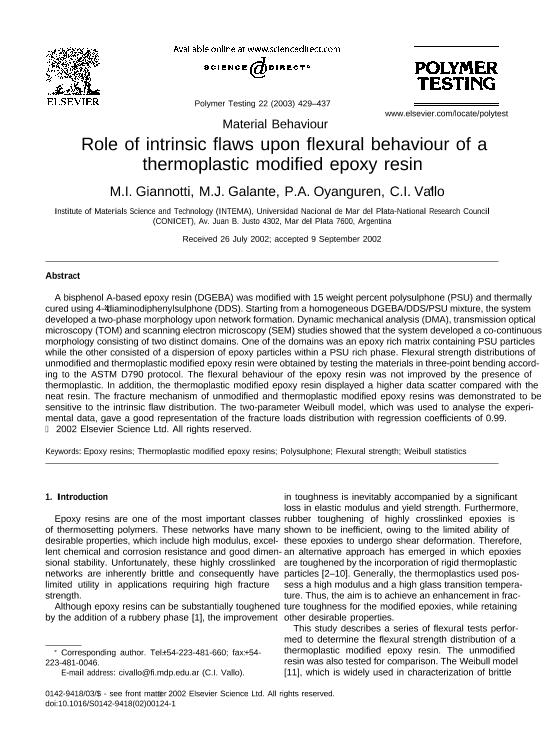Artículo
Role of intrinsic flaws upon flexural behaviour of a thermoplastic modified epoxy resin
Fecha de publicación:
06/2003
Editorial:
Elsevier
Revista:
Polymer Testing
ISSN:
0142-9418
Idioma:
Inglés
Tipo de recurso:
Artículo publicado
Clasificación temática:
Resumen
A bisphenol A-based epoxy resin (DGEBA) was modified with 15 weight percent polysulphone (PSU) and thermally cured using 4-4′diaminodiphenylsulphone (DDS). Starting from a homogeneous DGEBA/DDS/PSU mixture, the system developed a two-phase morphology upon network formation. Dynamic mechanical analysis (DMA), transmission optical microscopy (TOM) and scanning electron microscopy (SEM) studies showed that the system developed a co-continuous morphology consisting of two distinct domains. One of the domains was an epoxy rich matrix containing PSU particles while the other consisted of a dispersion of epoxy particles within a PSU rich phase. Flexural strength distributions of unmodified and thermoplastic modified epoxy resin were obtained by testing the materials in three-point bending according to the ASTM D790 protocol. The flexural behaviour of the epoxy resin was not improved by the presence of thermoplastic. In addition, the thermoplastic modified epoxy resin displayed a higher data scatter compared with the neat resin. The fracture mechanism of unmodified and thermoplastic modified epoxy resins was demonstrated to be sensitive to the intrinsic flaw distribution. The two-parameter Weibull model, which was used to analyse the experimental data, gave a good representation of the fracture loads distribution with regression coefficients of 0.99.
Archivos asociados
Licencia
Identificadores
Colecciones
Articulos(INTEMA)
Articulos de INST.DE INV.EN CIENCIA Y TECNOL.MATERIALES (I)
Articulos de INST.DE INV.EN CIENCIA Y TECNOL.MATERIALES (I)
Citación
Giannotti, Marina Inés; Galante, Maria Jose; Oyanguren, Patricia Angelica; Vallo, Claudia Ines; Role of intrinsic flaws upon flexural behaviour of a thermoplastic modified epoxy resin; Elsevier; Polymer Testing; 22; 4; 6-2003; 429-437
Compartir
Altmétricas




